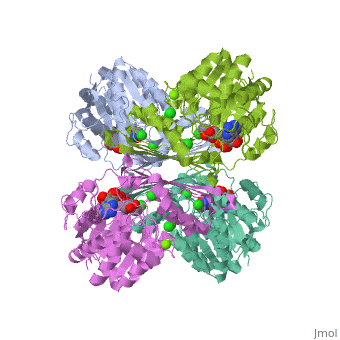User:Yash Patankar/Sandbox 1
From Proteopedia
Hsp90
This is a placeholder text to help you get started in placing a Jmol applet on your page. At any time, click "Show Preview" at the bottom of this page to see how it goes.
Replace the PDB id after the STRUCTURE_ and after PDB= to load and display another structure.
| |||||||||
| 3cin, resolution 1.70Å () | |||||||||
|---|---|---|---|---|---|---|---|---|---|
| Ligands: | , , | ||||||||
| Gene: | TM1419, TM_1419 (Thermotoga maritima MSB8) | ||||||||
| Activity: | Inositol-3-phosphate synthase, with EC number 5.5.1.4 | ||||||||
| |||||||||
| |||||||||
| Resources: | FirstGlance, OCA, RCSB, PDBsum, TOPSAN | ||||||||
| Coordinates: | save as pdb, mmCIF, xml | ||||||||
Hsp90, a 90 kDa heat-shock protein, is a ubiquitous molecular chaperone responsible for the governing of protein folding and regulation of many eukaryotic signaling pathways in the cell (Ali et al., 2006). It is a non-fibrous protein involved in the activation of many regulatory and signaling client proteins under normal conditions in addition to the refolding of misfolding of a number of proteins during stress (Ali et al., 2006; Pearl et al., 2008). Hsp90 is one of the most abundant proteins expressed in cells and it has been estimated to constitute upto 2% of the cellular proteins (Dollins et al., 2007). Hsp90 is found in all eukaryotes as well as bacteria with the exception of archae (Chen et al., 2006). Hsp90 has been shown to act as a buffer or capacitor of genetic variation in morphological evolution in Drosophila and other model organisms (Rutherford et al., 2007). Hsp90 is known to be required for the function of protein kinases such as ErbB2m Cdk4, B-Raf and Akt/protein kinase which are upregualted in cancerous cells (Pearl, 2005).
The function of Hsp90 depends on its ability to hydrolyze ATP after it binds in the active site of the protein and hence, the inhibition of Hsp90 by ATP competitors or non-hydrolyzable ATP analogs leads to the promotion of client degradation.


